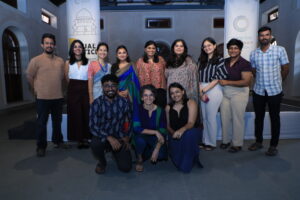On 22nd and 23rd of March, 2024, the Centre for Law and Policy Research (CLPR) organised a 2-day National Consultation to analyse systemic barriers that hinder women’s advancement to leadership positions in the judiciary and discuss legal and institutional reforms that can promote gender equality. This is a part of CLPR’s research initiative, “Equal Justice,” which seeks to address systemic and structural gender discrimination in the higher judiciary and the low numbers of women judges in the High Courts and Supreme Court of India. The Consultation included thematic panel discussions composed of retired judges, academics, legal professionals, Bar leaders, and media representatives to explore solutions for gender inclusion in the judiciary. The panels were designed to collect substantive insights on the existing challenges to gender inclusion efforts, build consensus for transformative change institution and strategise approaches for reform.
Session 1: Levelling the Scales: Bar Associations as Catalysts for Gender Equality
Panelists: Prashant Kumar (President, Bar Association of India), N. Krishnaveni (Senior Advocate) and Anita Shekhar Castellino (Advocate and Executive Committee Member, Bombay Bar Association and Convenor, Interactive Lawyers Association of Women).
Facilitator: Vibha Datta Makhija, Senior Advocate, Supreme Court of India
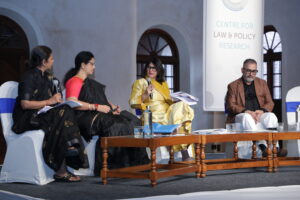
Ms. Makhija facilitated the first panel of the day, a power-packed panel of bar leaders to examine the pivotal role of bar associations in fostering gender diversity within the judiciary.
Ms. Krishnaveni, who was the first woman President elected to the Madras High Court Bar Association (Madurai Bench) spoke about the importance of women standing for elected bar posts. She opined that women lawyers presume failure and are not encouraged to contest for these leadership posts. In her case, she was elected to the post of Secretary first, following which she was unanimously elected as President, and credited her self-confidence at that time. She also advocated for women lawyers becoming a part of mixed-gender bar associations, instead of becoming relegated to women-only bar associations, to advance their visibility and networks. She also said that the threat of sexual harassment was a barrier for women in the profession and urged bar associations to form committees to eradicate the practices of harassment and to make the courts a safe working environment for women.
Mr. Prashant Kumar, being a member of the International Legal Assistance Consortium, provided insights from his international experience in bringing gender inclusivity to the fore in India. He delineated two measures that the Bar Association of India has already begun to take up: First, the reservation of 50% of State Secretary posts for women and second, the BAI is creating a mentoring program in specific areas of law such as criminal law in states such as Rajasthan, Uttar Pradesh and Odisha to mentor and train women lawyers and to generate a specialisation. Mr. Prashant Kumar highlighted the need for a constitutionally independent specialised machinery in the form of a Secretariat for judicial appointments. He suggested reforms to the current framework of the male-dominated Collegium towards a more open network where meritorious candidates are able to come forward, and where their candidature is not subject to individual choices.
Ms. Castellino spoke about the role of ILAW to advocate successfully for the inclusion of 5 posts in the Bombay Bar Association’s Executive Committee, including letters to the Law Minister and sustained lobbying with the Bombay Bar Association leadership. Ultimately, the act of reservation itself encouraged more women to apply, and 3 of the 5 women elected to the BBA secured more votes than many male candidates, eradicating the idea that the women candidates did not have “merit”. She highlighted the various challenges faced by young women lawyers which ought to be addressed by Bar Associations, for which women’s representation in Bar leadership was crucial. She emphasised that “just empowering women is not enough; women need a seat at the table.” Ms. Castellino pointed out that Maharashtra has plenty of women who are willing to come forward, however they are not given the opportunity. On the issue of judicial appointments, she suggested that the requirement of 10 years continuous practice ought to be relaxed for women who have gaps as a result of maternity leave or caregiving.
The panel then responded to questions from the audience. On judicial accountability Mr. Prashant Kumar gave an example of Israel where due to a protest by the Israeli Bar, there was an Ombudsman set up, which was independent and insulated from executive control. He said similar ideas must be pushed in India to hold the court to account. Ms. Castellino also cited an example from the 1990s where, as a result of resolutions moved by the Bombay Bar against five sitting judges due to corruption, three judges were transferred and 2 resigned.
On judicial appointments of women, Ms. Castellino observed that the judiciary has always shied away from transparency in providing reasons for rejection of names of women candidates, citing the privacy of the candidates. While Bar Associations can write for an explanation, it is doubtful that the Collegium will agree. Ms. Krishnaveni, also supported the idea of bar associations writing to the collegium to follow up on recommendations. Mr. Kumar cited the issue that Bar Associations currently do not know which names are under consideration until the process has concluded, making it difficult to provide support to the women candidates. He reiterated the need for a Secretariat to the collegium to ensure clear administrative processes are in place to bring about greater transparency.
Session 2: Justice in Numbers: Data-Led Law Reform
Panelists: Prof. (Dr.) Aparna Chandra (Professor, National Law School of India University), Prof. (Dr.) Rangin Tripathy (Professor, National Law University of Odisha), Apoorv Anand (Head of Data Operations, Data for India) and Nithya Rhea Rajshekhar (Senior Research Associate, CLPR)
Facilitator: Disha Chaudhari, Senior Research Associate, CLPR
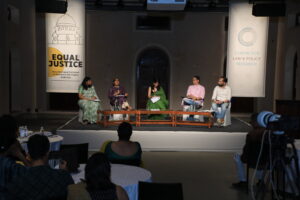
The second panel, facilitated by Ms. Chaudhari, delved into how data analytics and evidence-based research can be harnessed to catalyse transformative reforms aimed at augmenting gender diversity within the judiciary, and the current challenges.
Prof. Chandra spoke about the challenges of harnessing data from the judicial institution, which was key to analysing problems and bringing about evidence-based law reforms. She emphasised the importance of data in describing the reality of the judicial institution, and anchoring ideas in facts rather than anecdotal evidence, which may be highly subjective. She then addressed the challenges of data gathering about the Indian higher judiciary, as legal institutions do not gather data in a systematic way. She gave the example of data on women clearing bar exams, which is only available in physical form, making it inaccessible. She stated that Bar Councils and the judiciary should be pushed to properly maintain and publish data, even if it is anonymous or aggregated. Significantly, Prof. Chandra refuted the idea that the absence of gender diversity in the judiciary was only a pipeline problem which would gradually be resolved as more women joined the profession, stating that the data shows otherwise. Instead, there are several structural issues which prevent women from joining and further barriers once they enter the profession to advancement. Further, there was no active push by collegiums to ensure gender diversity.
Prof. Tripathy, reflecting on his experience collecting judicial data for the KHOJ (Know your High Court Judges) project, spoke about how the collegium system has resulted in narrowing the scope of consideration for elevation of high court judges to the Supreme Court, with SC judges largely being selected from among Chief Justices. He stated that data on gender diversity is usually descriptive in nature: it only provides the number of women judges appointed over the last 10 to 20 years. He stated that what is required is to go beyond these numbers to enable us to bring about reform. Data can show what happens to women after they are appointed as judges, whether they are given administrative leadership positions, their bench allocations etc. Prof. Tripathy pointed out that 2006 was the last time when a woman judge who was a part of the collegium was actively involved in the appointment of other women judges. Prof. Tripathy also advocated for the public raising questions not only of the Chief Justice of India but to the other collegium judges to better understand and hold accountable all the decision-makers involved in appointments.
Next, Mr. Anand addressed issues of accessibility of data from legal institutions. He talked about his work on the Justice Hub project, and pointed out that quantitative legal research is an interdisciplinary field and a time intensive procedure as it may take up to six to eight months just to collect and clean the data that is available. This becomes very difficult for sustaining data collection. These processes would be simpler if at the source, the data is properly collected and categorised. He emphasised the need to create more demand for data points to ensure that the quality of data also increases.
Ms. Rajshekhar presented the research CLPR has been doing as part of the Equal Justice project and highlighted some of the key findings, which point towards gender bias in judicial appointments. In comparing the representation of women appointed from the bar and from the subordinate judiciary to the High Courts, the data shows that it is women lawyers who are being appointed at the lowest rates. Women make up 27.6% of the High Court judges who are elevated from the bench, but only 11% of High Court judges who are elevated from the bar. There is a 2:1 norm which requires 2/3rds of judges to be appointed from the bar, but it is apparent that it was not being followed for women. She stated that it is important that representation is to be counted against population of the country and not merely in terms of the number of women lawyers. She concluded by stating that there is a lot of potential for more qualitative data analysis to take place and the data available to us at the moment is a reminder that the appointment system needs to be challenged.
Session 3: Judicial Diversity: Reflections from Former Judges
Panelists: Justice (Retd.) Mukta Gupta (Former Judge, Delhi High Court), Justice (Retd.) Ashok Hinchigeri (Chairman, Law Commission of Karnataka and Former Judge of the Karnataka High Court) and Justice (Retd.) S. Sujatha (Judicial Member, CAT Bengaluru and Former Judge of the Karnataka High Court)
Facilitator: Jayna Kothari, Senior Advocate and Executive Director, CLPR
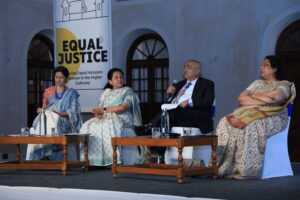
Day 2 of the Consultation began with a panel comprising three former judges of High Courts who were invited to provide their insights on the pathways to increase women’s representation in the higher judiciary, drawing from their own experience of the institution. Ms. Kothari facilitated the session.
Retd. Justice Mukta Gupta pointed out the significant challenges women face rising to leadership positions in law due to the demanding nature of the profession and the disproportionate domestic disruptions caused by marriage, childcare, and family responsibilities. They also face client confidence issues and societal perceptions prevent them from obtaining high-stakes briefs and consistent recognition. The lack of opportunities leads many women to leave the legal profession. She suggested that the private sector should make concerted efforts to brief women lawyers. She noted the importance of ensuring inclusivity and diversity at all stages, and said it was crucial to address the underrepresentation of women from marginalised groups as the challenges faced by them are compounded. She also suggested that collegiums should proactively identify women lawyers from beyond just the High Courts, and also look to district courts and other fora.
Retd. Justice Ashok Hinchigeri, emphasised the need for more women in the higher judiciary to bring diverse perspectives and disrupt male-dominated narratives and suggested a number of actionable strategies to ensure gender parity in higher judiciary appointments, including:
- Amending or reinterpreting Article 232(2) of the Constitution which notes that the eligibility for the appointment of advocates as District Judges is minimum 7 years of practice. The requirement of continuous practice should be removed to account for the disruptions faced by women on account of their disproportionate familial responsibilities.
- Reserving 33% of seats for women in judicial appointments to the higher judiciary.
- Including women’s names in every list of candidates considered by the collegium, which is similar to resolution adopted by the European Court of Human Rights (Resolution 1366 in 2004) to have all lists of candidates include names of women.
- In the short-term, propose an all-women list of candidates for elevation from the Bar, to ensure compliance with the 2:1 ratio and then subsequently have names of women included in each list, with appointments being made annually rather than waiting for vacancies to accumulate.
- Proactively appointing more women as Ad Hoc judges of High Courts and on the retirement of a woman judge from the Bench, that vacancy must be filled by appointing women.
- Altering the composition of the collegium by ensuring that in addition to the three senior most judges, the senior most female judge in each court is consulted on all appointments.
Retd. Justice S. Sujatha began by shedding light on the need for a conversation on diversity and inclusion in judicial appointments, stating that diversity was critical for upholding constitutional values. She suggested various steps to increase women’s representation in the higher judiciary, including:
- Implementing affirmative action measures including 1/3rd reservation for women in law officers’ posts and government pleaders, which is a critical pipeline for women lawyers.
- Addressing the infrastructural challenges within courts.
- Emphasizing India’s international human rights obligations under the International Covenant on Economic Social and Cultural Rights which mandate state parties to take measures to promote women in the workplace. Further, she highlighted the Supreme Court’s judgments in Aditi Kumar Sharma v. State of MP and Sarita Chaudhary. State of MP (2025), Col. Nitisha v. Indian Army (2021) and Ministry of Defence v. Babita Puniya (2020) which reaffirm the constitutional obligations to promote gender equality.
- Justice Sujatha reiterated the suggestion made by Justice Hinchigeri that there should be minimum one name of a woman lawyer in each list of recommendations to the High Court.
Session 4: Reporting Justice: Media’s Role in Judicial Gender Diversity
Panelists: Apurva Vishwanath (National Legal Editor, The Indian Express), Jyoti Yadav (Assistant Editor, The Print) and Vakasha Sachdev (Senior Manager, Corporate Affairs, Logically and Former Editor, Legal, The Quint)
Facilitator: Gauri Kashyap (Associate Editor, Supreme Court Observer)
Ms. Kashyap, facilitating the media panel opened the discussion observing the power of storytelling and narrative building in shedding lights on deeply rooted problems such as the lack of gender diversity.
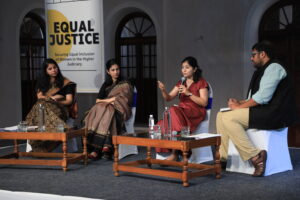
Ms. Vishwanath provided insights into how gender is treated within the courtroom, speaking from her experience as a court reporter. She gave the example of a case of the rape and murder of a woman, where during a hearing, one of the presiding judges made an inappropriate joke about her death with no concern for the victim’s parents who were present. This sets the tone for the proceeding, and reaffirms how courtrooms continue to be a hostile space for women. The role of the media is to unpack these sides to the story and also identify their own biases while reporting. On judicial appointments, she raised the issue of women not having access to spaces where their names are being discussed and considered as judges. This is where the media can ensure that names of women judges and lawyers are listed in their reportage. Further, the media should address the power equations between male and female judges and advocates in their stories. While online hearings have enabled people to see context in which judges say insensitive things, journalists can through a faithful telling of what happens in a courtroom in a specific context hold them accountable.
Ms. Yadav spoke about her experience writing series, ‘Women in Courts’ where she investigated various issues faced by women judges in the lower judiciary. She spoke about the importance of the media looking beyond big numbers or headlines and the increasing numbers of women clearing the judicial services exams, to unpack the unreported challenges faced by them. In addition to infrastructure challenges, she highlighted the various gender stereotypes that women judges continue to face; they are policed in terms of how they are supposed to dress outside court and whether are too strict or too lenient. They are also targets of sexual harassmen by male lawyers. Since judges are often not accessible and cannot speak out in the open, it is the responsibility of the media to bring to light what they’re going through. She also emphasised the need for the media to push back against social media narratives which perpetuate such gender stereotypes.
Mr. Sachdev spoke about how the media is currently covering the lack of gender diversity in the judiciary, and what needs to be done next. He raised the problem of the lack of consistency by the media in raising these issues and following up on a regular basis, and the failure to engage in discussions about why women are absent in the judiciary. He noted the need for more reporters to directly question judges responsible for making appointments. Mr. Sachdev suggested that the media on the whole should adopt a cohesive strategy for how they cover gender in the judiciary, including tracking appointments, addressing structural issues and keeping an eye on what’s being said in the courtrooms. He also pointed to the dangers of coordinated online campaigns to push back on gender inclusivity and how these are no longer on the fringes. These narratives need to be actively called out by the media.
